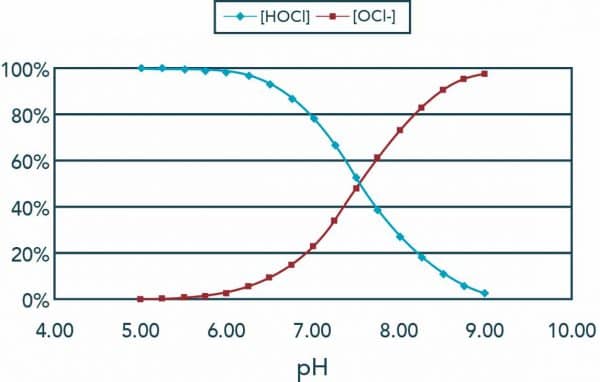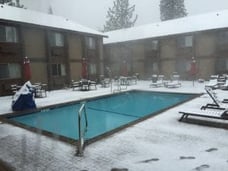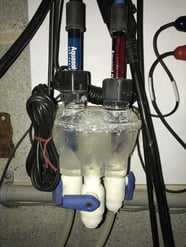ORP and LSI: The Future of Water Chemistry

Way back in 1984 I founded my service and repair company, The Pool Surgeon. I had no idea what ORP and LSI abbreviations meant, let alone their definitions. To be completely honest with you, I am not certain I was any better informed in the first 25 years of my pool career. As ashamed as I am to admit it, I'm admitting it because it's the truth.
Today we understand ORP and LSI, and my company teaches these topics to the pool industry and homeowners alike. I want to talk about why I firmly believe ORP and LSI are the future of pool chemistry and water treatment. You're about to get my unfiltered opinion, backed by empirical evidence throughout my career in the industry.
ORP
I want to begin with ORP, which stands for Oxidation Reduction Potential. ORP is the objective measurement of sanitizer performance. According to Robert Lowry:
"[ORP] is a measurement of a body of water's ability to oxidize contaminants. Measured with an electrode and electronic meter. It is an indication of the sanitizing level or degree of safety from disease in the water. Measured in millivolts with the accepted minimum level being 650mV." - Glossary, IPSSA Basic Training Manual, pg. 184
So what does that mean? I'll tell you what it means to me. ORP is the water's ability to sustain a safe swimming environment, therein minimizing the risk of people getting sick from a pool. The crazy thing about ORP–which I find fascinating–is that ORP can be the same level at 1 ppm chlorine or 10+ ppm chlorine. There are other factors in play. So while it's essential to pool chemistry, measuring free available chlorine (FAC) only tells a partial story.
I believe the best practice for water management is free available chlorine testing along with ORP. The two together give a more complete understanding of the safety of water.
Related: ORP vs. Free Chlorine - which is more important?
Factors that affect ORP
pH is the first and foremost factor that affects both ORP and LSI. We already know pH has an inverse correlation to strength of chlorine, vis-a-vis hypochlorous acid (HOCl) vs. hypochlorite ion (OCl-). The lower the pH, the higher the percentage of HOCl, and therefore the stronger the chlorine. Because of the higher percentage of hypochlorous acid at a lower pH, the ORP will be higher in lower pH water.
 Another factor that affects ORP is stabilizer. Cyanuric acid deceptively lowers ORP by tying up free available chlorine. Here again, free available chlorine might still show up on a chlorine test with high CYA in the pool–but if the ORP is low because of it, sanitization is compromised. My point, again, is testing chlorine alone will not tell you the whole story.
Another factor that affects ORP is stabilizer. Cyanuric acid deceptively lowers ORP by tying up free available chlorine. Here again, free available chlorine might still show up on a chlorine test with high CYA in the pool–but if the ORP is low because of it, sanitization is compromised. My point, again, is testing chlorine alone will not tell you the whole story.ORP, in my opinion, is a much more reliable measure of confidence in water quality. That is, until its sensors get distorted readings (possibly due to dirty electronic probes?). Contaminants like bather waste can adhere to the probe itself, distorting its ability to accurately read ORP. Another issue in ORP accuracy is cloudy water.
Some in the industry regard this as a "false reading." I personally liken this to a smoke detector with a dying battery. Would you pull the battery out of the beeping smoke detector in your home if your grandchildren were sleeping over? Or would you figure out why it's beeping and solve that problem?
If you're getting a distorted ORP reading, do something about it! Clean the probes at the very least. I urge you not to treat and ORP alarm as a nuisance to overlook and ignore.

We habitually over-chlorinate swimming pools
I believe that we as an industry are grossly over-chlorinating our water in an attempt to meet given requirements; requirements meant to protect people. Over-chlorination accomplishes bright, clean water...or so we think. Years ago I traveled to India to work with them and learn how they treat their water. You might be shocked–literally–if you got in some of their swimming pools. As a practice, they would run very high chlorine levels and very low (6.0 to 7.0) pH. But wow did their water look great!
Too bad those same pools were loaded with black algae and had dangerously low ORP.
Throwing more chlorine at the problem can be problematic too. The EPA legal limit for maximum chlorine level in a commercial pool is 4 mg/L (ppm):
"EPA has not approved any POOL product use above 4 PPM (MG/L) FAC or spa product use above 5 PPM (MG/L) FAC when BATHERS are present. The maximum FAC level approved for POOLS is consistent with EPA’s Maximum Residual Disinfectant Level of 4 PPM (MG/L) for drinking water." - US Centers for Disease Control, Model Aquatic Health Code, Page 25.
Four parts per million? The number makes me laugh out loud. I would argue the regulation is overlooked by public health officials and pool operators with regularity. Hell, I didn't know. If I left a backyard pool with just 4 ppm chlorine, a week later it could have algae in it. But rather than scoffing at the law, I chose to rethink how I treat water. After all, our mission statement at Orenda is changing the way the world thinks about water.
Honestly, I look at the excessive use of Trichlor and Dichlor in the pool business and have a growing concern for more than just high CYA. Not only are chlorine levels needing to be higher and higher just to get a free chlorine residual (CYA has 7.5% reduction factor on FAC), but the higher your stabilizer levels, the lower your ORP and LSI.
In order to maintain safe and well-maintained water chemistry with an EPA-compliant chlorine level, high levels of CYA is simply unnecessary. In my opinion, I don't see a benefit of going over 30ppm CYA. But in any case, to keep ORP in a reasonable range, it may take secondary chemicals and/or systems like UV to help chlorine be more efficient.
LSI
The second metric I believe is paramount is the LSI, the Langelier Saturation Index. Six factors make up the LSI. In order of priority, in my opinion:
- Water Temperature
- Calcium Hardness
- pH
- Carbonate Alkalinity
- Stabilizer (CYA)
- Total Dissolved Solids (TDS)
The LSI has also been referred to as the corrosion index. Simply put, the LSI is a measurement that determines the calcium carbonate saturation in water. LSI determines if water is corrosive (under-saturated, low LSI), balanced, or scale-forming (over-saturated, high LSI). Commercial and industrial water treatment applications use the LSI as an objective measure of water balance. Cooling towers, waste water, drinking water, irrigation, you name it. The LSI is the unbiased truth.
LSI balance is a value between -0.30 and +0.30. As we learn more about this index, some pool professionals alter it to be -0.3 to +0.5, because it is wiser to err to the side of scale formation than corrosion. While I personally have no objection to raising the high parameter to +0.5 in most cases, it can become a concern with heaters, salt cells and other warm water applications like spas and hot tubs.

Scale is treatable. Corrosion is permanent.
When I learned the LSI, it was like blunt trauma. I was so mistaken for so long. The message that resonated with me was that scale is treatable, but corrosion and etching are permanent. Having an LSI below -0.3 means water chemistry that can cause permanent, irreversible damage to surfaces of all kinds (plaster, fiberglass, vinyl liner) and equipment (both metal and plastic). Water will stop at nothing to reach balance. Even if it has to chew through your pool to find it.
As a practical view, my personal bias is to make 0.00 LSI my low minimum, and shoot for higher levels of LSI. Why? Because scale is treatable. In fact, our customers routinely treat scale with our SC-1000, which gently dissolves the calcium back into solution, causing no damage to the pool.
Take your pool's temperature!
 The LSI will never lie. LSI balance needs to be strived for every time you visit the pool. Test all the factors and do NOT forget about water temperature! Changing water temperature has a HUGE IMPACT on the LSI. I advocate for every pool to have a thermometer in it, and every pool service tech to have a thermometer with them for every pool they visit. Yes, it's that important.
The LSI will never lie. LSI balance needs to be strived for every time you visit the pool. Test all the factors and do NOT forget about water temperature! Changing water temperature has a HUGE IMPACT on the LSI. I advocate for every pool to have a thermometer in it, and every pool service tech to have a thermometer with them for every pool they visit. Yes, it's that important.
The future has already arrived
In conclusion, I believe the future of pool chemistry–and indeed, water management in general–is based on ORP and LSI.
Positive change interferes with current practices that you may have grown comfortable with...but is it a trap? Professionalism and best practices as I described can help elevate your business to a new level in the industry. In turn, you can secure long-term customer relationships; a relationship that can be maintained for decades.
This conversation can elevate you in the eyes of your customer, building one priceless element: trust. Measure free chlorine and ORP. Measure pH, alkalinity and LSI. Go the extra step. It's worth it. Doing the same old thing and expecting better results is insane.
And by the way, the future I'm talking about? It has already been here for decades. ORP and LSI tools are available to you, and are used regularly in commercial and residential pools today. Technology exists so you can even control these pools from a smartphone. Contact your manufacturer of choice for their solution. What are you waiting for?

